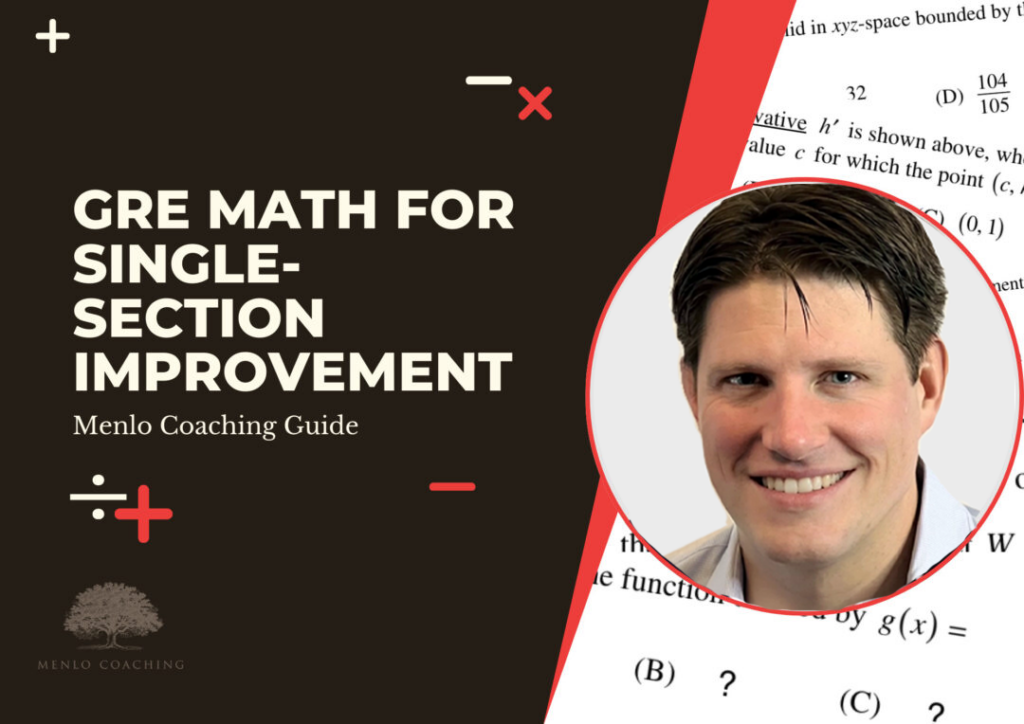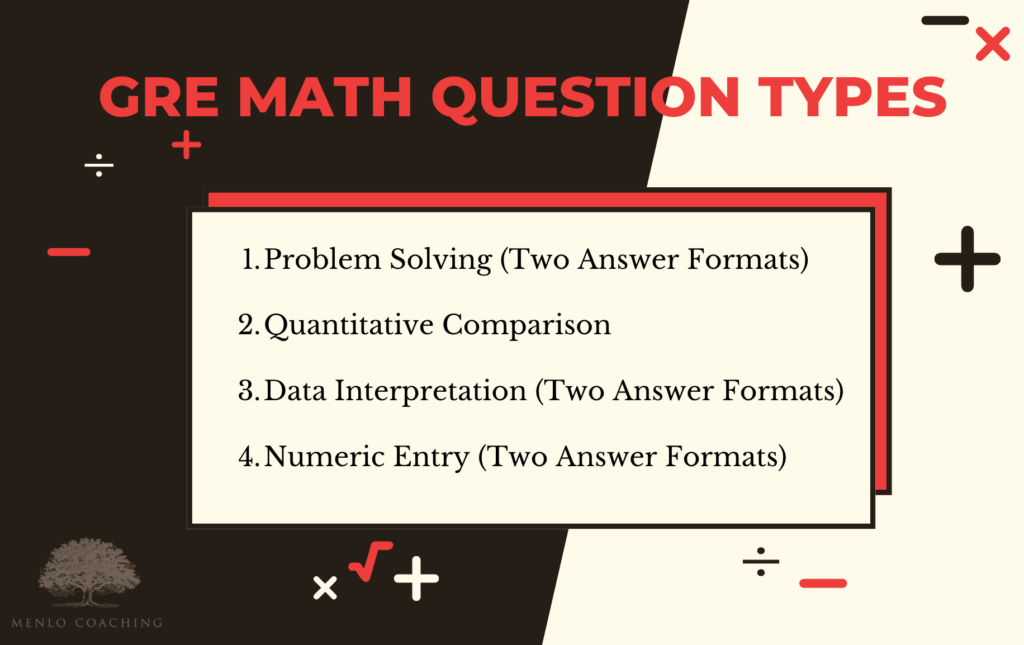When it comes to the GRE (Graduate Record Examination), aspiring graduate students understand the significance of mastering both Verbal and Quantitative Reasoning sections.
The Quantitative Reasoning (“Quant” or “Math”) section of the GRE demands precision, critical thinking, and a thorough grasp of mathematical concepts. Just as a high score in the Verbal Reasoning portion of the exam is indispensable for certain graduate programs and a high total score is important for ultra-competitive grad programs like MBA programs, a stellar Quant score holds equal weight for others—particularly in fields like engineering, mathematics, and economics.
This article is tailored for individuals aiming to excel in the Quantitative Reasoning section of the GRE, whether they are pursuing programs that prioritize quantitative skills or simply need to balance their overall GRE score with a strong showing in math.
We will delve into the intricacies of the Quant section, explore the types of questions asked, and equip you with strategies to conquer the GRE quant section on test day.

Like the Verbal Reasoning section, the Quantitative Reasoning measure of the GRE is split into two further subsections.
In total, the GRE Math section will take 47 minutes to complete. Its subsections last as follows:
The GRE is section-level adaptive, so your performance in Section One will determine the difficulty level in Section Two. Your total GRE Quantitative Reasoning measure score will be based on how many correct answers you get as well as the difficulty level of those questions.
Test takers are allowed to move back and forth between questions in each separate GRE Math section.
An on-screen calculator is provided for test takers on the entire Quant section of the GRE. This GRE calculator can add, subtract, multiply, divide, and find the square root.
If you read about the GRE on the ETS website, you’ll find that they refer to two different concepts as “question types”.
For the sake of clarity, we teach students to tie the question types together with their respective answer formats to simplify the process.
Working in this way, the question types and their respective answer formats are as follows:
1a. Problem Solving—Select One Answer
1b. Problem Solving—Select One or More Answers
2. Quantitative Comparison
3a. Data Interpretation—Select One Answer
3b. Data Interpretation—Select One or More Answers
4a. Numeric Entry—Single Box
4b. Numeric Entry—Double Box

Multiple Choice Problem Solving questions are the first of four main Math question-type variations tested on the new, shorter GRE exam.
The Problem Solving questions in the GRE Quantitative section aim to evaluate a test taker’s ability to use mathematical concepts to solve real-world problems effectively. While a solid understanding of fundamental mathematical principles is crucial, success on these questions also hinges on strategic thinking and efficient problem-solving techniques.
There are two types of Problem Solving questions on the GRE:
These questions ask the test taker to select only one correct answer from a list of five answer choices.
This type of multiple-choice question asks to you select one or more answer choices from a list of possible answers. The question will not necessarily tell you how many choices you must select.
The average (arithmetic mean) age of the people in group G is 41 years, and the average age of the people in Group H is 36 years. The average age of the people in the two groups combined is 38. If no person is in both groups, what fraction of the people in the two groups combined are in group H?
A. 2/5
B. 1/2
C. 3/5
D. 2/3
E. 3/4
To view the answer to this question, read our article on GRE Problem Solving questions.
Many people think of GRE problem-solving questions as just plain math questions, but in most cases, they are much more than that. The GRE is an effective exam because it does not simply measure basic mathematical skills—it is equally interested in your ability to reason based quantitatively based on the information available.
Although they are likely the most familiar GRE Math question type, many students approach problem solving questions in the wrong ways.
To succeed on GRE problem solving questions, test takers need the requisite knowledge related to the content area being tested—math skills related to arithmetic, algebra, geometry, statistics, etc. However, it is just as important to read the question carefully, leverage every hint, and choose the most efficient and effective strategy (e.g. backsolving, number picking, conceptual thinking, etc.).
To improve your results on problem solving questions, we recommend using the following tips:
Quantitative Comparison questions on the GRE ask test takers to evaluate and compare two quantities, designated as Quantity A and Quantity B, and determine the relationship between them. These questions offer four possible answer choices:
To excel in Quantitative Comparison questions, it’s crucial to grasp the structure of these questions and employ effective strategies for comparison. Here are some tips to enhance your performance:
By applying these strategies and familiarizing yourself with the structure of Quantitative Comparison questions, you can enhance your ability to analyze and compare quantities effectively within the given time constraints. Practice using these techniques to sharpen your quantitative reasoning skills and optimize your performance on the GRE exam.
Test takers should use official GRE Quantitative Comparison practice questions to prepare effectively for this section of the exam.
(x + 5)² – (y – 3)² = 0
x + y = 2
Quantity A: x – y
Quantity B: 0
A. Quantity A is greater.
B. Quantity B is greater.
C. The two quantities are equal.
D. The relationship cannot be determined from the information given.
To view the answer to this question, read our article on GRE Quantitative Comparison Practice Questions.
Data Interpretation questions ask test takers to refer to a specific table, graph, or other visual display. These questions require the test taker to be able to interpret and analyze data and are typically multiple-choice questions (both types).
Data interpretation involves visualizing and comprehending data presented in various formats. Usually, each set comprises three questions, allowing candidates to delve deeper into the information provided.
To excel in Data Interpretation questions, practice interpreting various types of data presentations, such as pie charts, column charts, line charts, and scatter plots. Familiarize yourself with strategies for efficiently extracting information and answering questions accurately within the given time constraints.
Although Data Interpretation questions may initially appear challenging, with consistent practice and the use of effective strategies, students can make significant improvements to their Data Interpretation score and, by extension, their overall GRE score.
Numeric entry questions ask test taker to manually type their answer as an integer, decimal, or fraction depending on the question rather than selecting from multiple-choice options. In these questions, test takers will be presented with a problem or scenario that requires a quantitative solution.
A single answer box will be provided for integer or decimal answers, and two separate boxes will be provided for fractional answers – one for the numerator and one for the denominator.
Numeric Entry questions assess your ability to perform mathematical calculations accurately and efficiently. They cover a wide range of mathematical concepts, including arithmetic, algebra, geometry, and statistics. These questions often involve solving equations, finding numerical values, or performing calculations based on given data or conditions.
It’s essential to pay attention to formatting guidelines when entering your answer, such as decimal points, fractions, or scientific notation, as incorrect formatting may result in an incorrect response.
Most test takers need to study over a timeframe of two to three months to achieve their target GRE Quant score. It takes time to build a deep understanding of the tested concepts, grasp specific strategies, complete enough GRE math practice questions for each concept under timed and untimed conditions.
The GRE Quant section includes questions relating to Arithmetic, Algebra, Geometry, and Data Analysis topics. Most test takers will have been exposed to these topics in high school, through Algebra and Introduction to Statistics courses. Higher level math content areas, such as Trigonometry or Calculus, do not appear in the GRE Math section. Additionally, the Quantitative Reasoning section uses standard, high-school level mathematical symbols, terminology, and conventions.
ETS offers a free GRE Math Review, which identifies most topics that will appear in the Quantitative Reasoning section. However, looking over the Math Review is not the only thing you need to do to prepare for this section of the GRE. Rather, you need to spend ample time figuring out the best way to solve official GRE practice problems to gain enough experience to excel on the actual exam.
Quantitative Reasoning questions on the GRE are made to be complicated and disguise what GRE math concepts are being targeted. This section tests your ability to think with math skills, rather than just solve math problems robotically. Therefore, instead of spending too much time memorizing formulae, effective GRE preparation involves working through ample official GRE practice questions, keeping track of the mistakes you make.
Finally, a strong GRE study plan can make all the difference when preparing for the Quant section of the GRE. With a structured plan, students can avoid spending any more time on the GRE than they absolutely have to.
Excelling in the GRE Quantitative Reasoning section requires a strategic approach and thorough preparation. From understanding the structure and types of questions to mastering efficient problem-solving techniques, test-takers must have a strong foundation in various mathematical concepts and be flexible and strategic in their application. Consistent practice with official GRE materials, a thorough study plan, and a focus on recognizing patterns and avoiding common pitfalls can significantly enhance your performance on test day.
If you’re seeking personalized guidance and tailored GRE quant strategies, Menlo Coaching offers expert GRE Tutoring that has been proven to maximize your performance in the GRE exam. Our curriculum is tailored to each student’s individual strengths and weaknesses, as well as their needs—so if you only need support in the Quant section of the exam, our tutors can provide the guidance you need.